The Gulf Coast Express (GCX) pipeline is a 720km-long gas pipeline developed by Kinder Morgan Texas Pipeline (KMTP), a subsidiary of Kinder Morgan, in the Permian Basin in Waha, Texas, US. The pipeline entered service in September 2019.
Kinder Morgan holds 34% interest and is the operator of the pipeline, while the other stakeholders are Altus Midstream, DCP Midstream and an affiliate of Targa Resources.
KMTP and DCP signed a letter of intent (LOI) for the development of the Gulf Coast Express pipeline in October 2017. The final investment decision was taken in December 2017, while construction on the £1.32bn ($1.75bn) pipeline project was started in May 2018.
The pipeline carries natural gas from the Permian production area to the hub near Agua Dulce, Texas. It also enables exports to Mexico and LNG liquefaction terminals on the Gulf coast, while meeting the growing demand for industrial customers.
The project is claimed to have generated 2,500 jobs for the local community during the construction phase and 15 full-time jobs after commencing operations. It was also expected to generate £26.5m ($35m) in tax revenue for the local counties and the state.
Gulf Coast Express pipeline design and route details
The GCX Project mainline is a 447.5-mile (720km), 42in diameter pipeline beginning from Waha Hub, Texas, and terminating near Agua Dulce, Texas.
A 50-mile (80.4km), 36in diameter lateral pipeline was also built, which serves the gas processing facilities of Targa Resources in the Permian’s Midland Basin as well as facilities jointly owned by Targa Resources and Pioneer Natural Resources.
The pipeline has an initial capacity of 2 billion cubic feet of gas per day (bcf/d) and an installed compression of 214,280hp.
Civil and environmental surveys on the project were conducted between December 2017 and June 2018. Construction of the midland lateral began in May 2018, while that of the GCX mainline began in October 2018.
The established receipt points for the pipeline are at El Paso Natural Gas (EPNG)/KMTP Mendoza Trails, EPNG Waha Header, DCP/Atmos Waha Header, ETC Trans-Pecos Header, Enterprise, Oasis, Transwestern, ONEOK Roadrunner, ONEOK West TX, Northern Natural Gas, and WhiteWater Midstream.
The delivery points of the pipeline are at KM Tejas/Texas/Border, Enbridge Valley Crossing, NET Mexico, HPL and Southcross. In addition, multiple pipeline interconnections are available at Agua Dulce, where the pipeline terminates.
Gas transportation agreements
The gas pipeline was initially launched with an available capacity of 220,000 dekatherms a day (Dth/d). Strong market demand, however, called for the addition of 60,000Dth/d of capacity.
By the end of 2017, 85% of the total capacity of the project was committed under long-term transportation agreements. The first transportation agreements were signed with Occidental Energy Marketing, a subsidiary of Occidental Petroleum Corporation, and Kaiser-Francis Oil Company.
DCP Mainstream, Apache Corporation, Pioneer Natural Resources, XTO Energy, and Targa are some of the companies that have already agreed for the shipment through the project.
Kinder Morgan reported a 26% increase in profit during the fourth quarter of 2019, which was attributed to higher gas transport volumes from the Permian Basin through its Gulf Coast Express pipeline.
Contractors involved
More than 3,000 contractors were engaged for the Gulf Coast Express pipeline project.
ABN GROUP TEXAS GROUP was contracted to provide construction services for the project.





